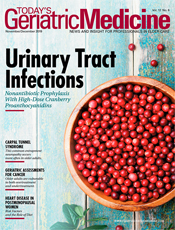
November/December 2019
Practice Matters: Documentation’s Effect on Value-Based Care One of the far-reaching impacts of the Affordable Care Act was its mandate that health insurance payers could no longer deny coverage to high-risk individuals, such as those with chronic or preexisting conditions. It threw health care’s entire economic system for a loop, especially considering that 5% of the sickest patients consume 50% of the spend, and the top 20% account for 80% of the spend. These figures are particularly concerning to hospitals and health systems that feature a large percentage of Medicare Advantage patients in their overall populations. Older patients are more likely to fall into the high-risk groups, which means their care requires more time and resources than does that of younger low-risk patients. Because Medicare Advantage payments are capitated, the Centers for Medicare & Medicaid Services (CMS) created risk-adjustment factors (RAFs) that enable hospitals and health systems to be compensated at a higher level than the standard for the additional work that is required. To be eligible for these payments, providers must meet two conditions: Each year, they must document all the patients who have a particular condition during a face-to-face visit, and they must document all the care they have delivered to those patients per the requirements of a value-based program. Failure to meet either condition results in nonpayment for that RAF. Take a patient with diabetes, for example. Between January 1 and December 31 of the same calendar year, the provider must document that the patient has diabetes using the appropriate hierarchical condition code (HCC)—even if the condition was documented the previous year. The provider must also document that the patient has received all the required care for that condition. Failure to document either means CMS does not recognize the care as an RAF and therefore will not pay an additional amount. Where it becomes particularly complex is that qualifying for the improved RAF score (and additional per member, per month payment) doesn’t mean that all the required care must be delivered by that provider or within that health system. In other words, as long as a diabetic foot exam is delivered and documented somewhere, it qualifies as meeting the requirements. Of course, that means the provider must have a line-of-sight view into all the care that is being delivered to each patient, as well as how CMS views the population and what conditions exist for their managed patients. However, a lack of interoperability means most electronic medical records (EMRs) fall far short of capturing encounter data from outside of the provider’s organization. Providers often try to supplement their data by partnering with their health plans to improve risk adjustment. However, this view may represent only a fragment of their overall population at a time, since each health plan’s view is restricted to the patients/members they share with the provider organization. The result is incomplete insights into the provider’s risk, quality, and performance across the overall population. Documentation’s Role On the clinical side, providers can stay ahead of managing the overall health of their patients, particularly those with chronic conditions. They will know what care gaps to close to better drive quality outcomes. This approach includes adding reminders to the EMR for providers to document chronic conditions during an unrelated encounter. Again, chronic conditions must be documented during face-to-face visits each year. The typical time to do that is during a wellness visit. But what if the provider forgets or assumes the condition has already been documented? A reminder in the EMR ensures that not only the proper level of care is being delivered but also the appropriate HCC is captured, improving the RAF so the provider receives reimbursement. Financially, HCCs require a greater level of specificity in order for RAFs to be measured properly. If providers code too low; don’t enter a procedure, test, or device into the record; or miss other seemingly minor steps, the accumulated difference can mean millions of dollars in lost revenue. In addition, those monies are unavailable for care. Enacting Change The following are several steps organizations have undertaken to boost documentation accuracy: • Enlist a physician champion to demonstrate how documentation improvement is in the best interests of patients as well as providers. • Demonstrate and communicate the value better documentation will yield for themselves and the organization, such as improved Star ratings and Healthcare Effectiveness Data and Information Set , or HEDIS/pay-for-performance, or P4P, scores that will help attract more patients. Also, demonstrate how capturing more revenue as a result of improving RAFs makes money available for more care management staff or access to other programs that will help drive better patient outcomes. • Create an aggregated view of data across all payers and augment it with CMS data to gain a single view across all payers, patients, and providers to allow care teams to focus on delivering high-priority care. • Augment physician efforts by using an expanded care team, such as nurse navigators, to support care and documentation gap closures. • Create transparency into CMS’ reality since that is the ultimate source of truth. Knowing what was received and accepted by CMS will help organizations achieve accurate risk profiling, RAF scores, and reimbursement. Better for All Improving documentation accuracy provides a foundation. When combined with predictive and prescriptive analytics, providers can quickly identify where risk exists across populations; intervene and engage to deliver high-quality, cost-effective care; and ensure they are reimbursed properly and fully for the great care that is being delivered. — Donna DuLong, MS, RN, FHIMSS, is a senior health care executive with SCIO Health Analytics, an EXL company, with more than 25 years of clinical operations and informatics expertise in various settings, including provider, academic, and health care technology companies. |
